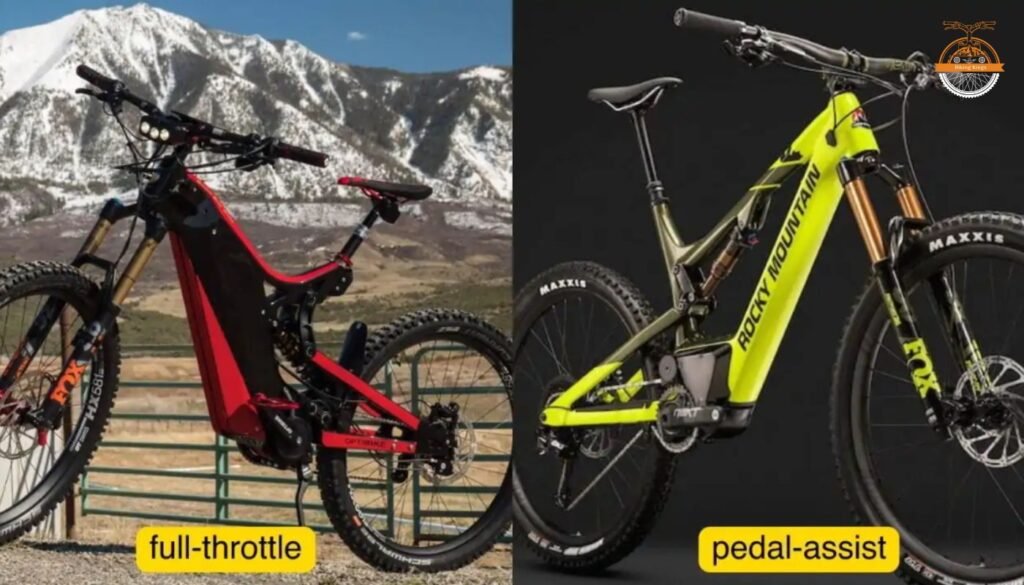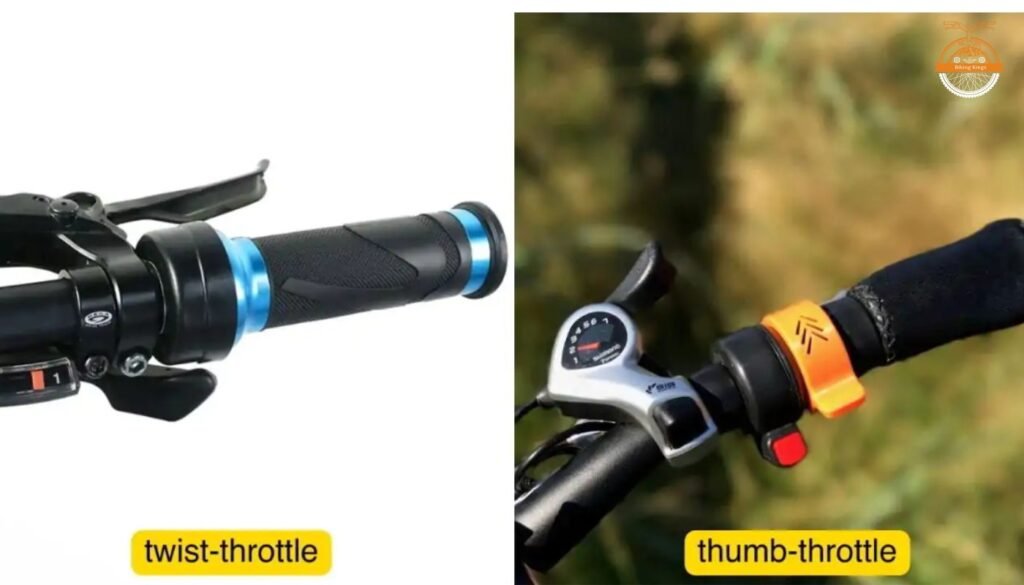Full-throttle vs Pedal Assisted e-bikes

Whether you prefer the fast and effortless nature of full-throttle or the fitness benefits of pedal assist, each type has its advantages. Many electric mountain bikes include various assistance modes, ensuring that whether you’re aiming for efficiency or speed, you’ll find a ride that suits your needs. With these options, the motor output adapts to your ride, ensuring a smooth journey within its programmed limit, putting you in control without compromising performance.
So, do you need to pedal an electric bike?
Well, you don’t strictly have to, but if you’re looking for electric mountain bikes specifically, they’re almost exclusively pedal-assisted only, and frankly, if you’re on a long trail, you’ll want the efficiency of a pedal-assisted motor.
Full-throttle e-bike
- Capable of powering wheels without pedal input
- Tend to be less economical
- Rarely have regenerative braking
- Less Common
Pedal-assisted e-bike
- Require rider to pedal for motor activation
- Capable of lasting much longer ranges
- Higher capacity for top speed
- More likely to utilise regenerative breaking
Electric bike throttle - How it works

Electric mountain bikes function with key components like the throttle, which plays a crucial role in controlling the bike’s motor. With a twist throttle, riders can easily activate the motor by simply twisting the handle, giving a seamless boost when navigating various terrains. Alternatively, a thumb throttle requires a gentle press on a spring-loaded paddle, allowing for controlled power as the rider pushes through tough paths or a thrilling blast across a dirt track. Whether it’s twisting the handle for a smooth acceleration or using your thumb to adjust speed, the throttle ensures you’re in command of your ride.
Electric bike wheels
Electric bike wheels are essential to both traditional MTB and E-mtb. The design of most MTB and Neo Mottera 1 or Neo Mottera 5 electronic bikes involves specialised wheels capable of supporting the additional weight of the electric motor and handling the increased torque. Some of these wheels are made from weaker alloys, which might bend or break under excessive pressure, especially when carrying heavy loads like a 150kg rider. A few rare companies, such as GeoOrbital, offer radically different styles of wheels, where the motor structure replaces traditional spokes to create a more robust and efficient solution. This design shift contributes to reinventing the wheel, offering a better ride for electric bikes.
ℹ️ Be cautious with your assistance use on hazardous technical sections – the bike’s heavyweight, combined with its immense power, could lead to a nasty accident if you aren’t careful or don’t have the strength to cope with it.
Electric bike batteries explained

The discharge and charge cycles repeat, supported by the advances in rechargeable batteries. Even though the tech nerds might dive deep into the intricate details, understanding how free electrons and current flow within the system gives insight into why these bikes are so efficient. According to the Office of Energy Efficiency, these advancements in battery technology are key to powering the future of transportation.
How lithium-ion batteries work
The battery discharges the charge, supplying power to the motor, while the separator keeps the ions and free electrons from mixing improperly. The Office of Energy Efficiency and Renewable Energy even offers a helpful animation that illustrates how lithium-ion batteries work, showing how current is generated, stored, and manipulated to power the device efficiently. With this system, electric mountain bikes deliver reliable power, ensuring that you can conquer any terrain with ease.
How to use an electric bike?
To use a pedal-assisted bike, all you have to do is:
- Turn on the bike
- Hop onto it
- Choose your assistance level
- Start pedalling
- Crush that trail
When it comes to using an e-bike, the experience differs slightly from a traditional bike, but it remains really easy for any user. Instead of pedaling manually all the time, riders can engage a full-throttle mode, allowing the bike to take over with minimal effort. With options like a twist throttle or a simple push button throttle, controlling the speed becomes intuitive. Whether you’re navigating tough trails or cruising through the city, the ride on an electric bike combines convenience with enjoyment, making it an accessible option for anyone looking for an effortless cycling experience.
How do electric mountain bikes work?

When it comes to understanding electric bikes, the principle is simple: a battery powers a motor, generating torque to move the bike’s wheels. Depending on the motor’s placement, it can be rear-mounted, front-mounted, or mid-drive mounted, each offering different benefits. Mid-drive mounts are favored for their balance and focus on power distribution, while other setups, like the GeoOrbital system, focus on more unusual wheel designs and unique battery-motor configurations. These variations allow for customization, making electric mountain bikes versatile, whether you’re looking for efficient hill climbing or better control on rugged trails.
Pros of Mid-drive motors
Compared to hub-mounted motors, the mid-drive mounted motors provide a stable and well-balanced experience, ideal for traversing rough or sketchier trails. The fact that they utilise standard bike parts such as shifters and derailleurs makes them easier to maintain, even for those with basic bike mechanics skills. For riders who enjoy riding hard, these motors are considered the gold standard in the world of electric mountain bikes, offering a powerful yet reliable system that’s easy to service without needing extensive e-bike specific knowledge. The mid-driven motors truly shine by combining efficiency and balance, making them a lifesaver for both casual and seasoned riders alike.
Cons of mid-drive e-bikes
This system offers an intuitive ride, adjusting the motor output in real-time for more control on mountain trails, especially during uphill climbs or when tackling intense technical climbs. While these bikes may exert increased forces on the drivetrain, leading to faster wear of standard bike parts like shifters and derailleurs, the trade-off is exceptional bike handling and trail control. Riders can switch between eco mode for longer battery life or throttle e-bike mode for quick bursts of speed, making them versatile for different riding styles.
Although they add to the overall motor weight, the motor assistance makes climbing less exhausting, and the integration of electric technology through cycle computers allows riders to monitor essential data such as battery range and terrain data. For those who regularly ride steep climbs, the motor balance of mid-drive motors provides a smoother, more controlled ride than hub-mounted systems, offering greater precision in technical riding environments.
Final Thoughts
Understanding how an electric mountain bike functions involves more than just its motor and throttles; it’s a fascinating dive into the arcane world of chemistry and rechargeable batteries. From the different types of bikes to the various mounting positions of the motor, each element plays a key role in how the bike performs. For those venturing into the realm of electric mountain biking, it’s not merely the technical details that matter but the sheer enjoyment these bikes bring. Whether you’re exploring the potential of an e-mtb or curious about their actual worth, there’s always more to uncover. If you’re still in doubt, our blog offers further encouragement to dive deeper into this world.


